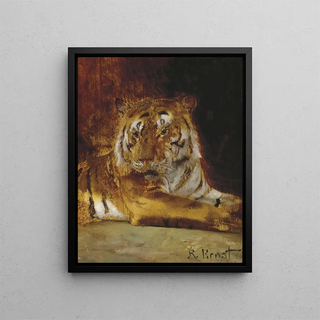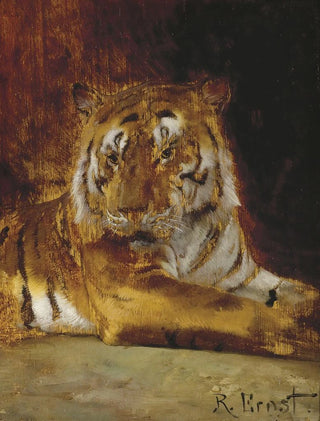Art print | Tiger - Rudolf Ernst


View from behind

Frame (optional)
Reproduction Tigre - Rudolf Ernst – Introduction captivante
The "Tiger" art print by Rudolf Ernst is a piece that immediately transports the viewer into a world filled with mystery and wild beauty. Created at the end of the 19th century, this canvas evokes the fascination that the artist had for oriental landscapes and the majestic wildlife that inhabits them. The tiger, a symbol of power and grace, is depicted here in all its splendor, capturing the very essence of wild nature. The work invites deep contemplation, where every detail seems to tell a story, an adventure at the heart of a lush environment. The light, colors, and textures intertwine to create a living, almost tangible tableau that draws the eye and sparks the imagination.
Style and uniqueness of the work
Rudolf Ernst's style is distinguished by his ability to blend realism and romanticism, offering a representation that is both faithful and poetic of his subjects. In "Tiger," the warm color nuances and shadow play reveal impressive technical mastery. The artist manages to capture not only the physical appearance of the tiger but also its indomitable character and majestic aura. The composition is carefully balanced, with the tiger occupying the foreground, while the surrounding scenery, rich in detail, creates an immersive atmosphere. The lush foliage and delicate textures of the fur are rendered with such precision that one can almost feel the warmth of the sun filtering through the branches. This work stands out for its emotional intensity, encouraging the viewer to feel the power of nature while reflecting on the relationship between humans and animals.
The artist and his influence
Rudolf Ernst, born in 1854 in Vienna, was an Austrian painter whose work is often associated with the Orientalist movement. His passion for distant cultures and his desire to capture their essence through art led him to travel to the Orient, influencing his style and thematic choices. Ernst successfully combined elements of European academic painting with exotic inspirations, creating works that transcend cultural boundaries. His unique approach not only marked his era but continues to inspire many contemporary artists.

Matte finish

View from behind

Frame (optional)
Reproduction Tigre - Rudolf Ernst – Introduction captivante
The "Tiger" art print by Rudolf Ernst is a piece that immediately transports the viewer into a world filled with mystery and wild beauty. Created at the end of the 19th century, this canvas evokes the fascination that the artist had for oriental landscapes and the majestic wildlife that inhabits them. The tiger, a symbol of power and grace, is depicted here in all its splendor, capturing the very essence of wild nature. The work invites deep contemplation, where every detail seems to tell a story, an adventure at the heart of a lush environment. The light, colors, and textures intertwine to create a living, almost tangible tableau that draws the eye and sparks the imagination.
Style and uniqueness of the work
Rudolf Ernst's style is distinguished by his ability to blend realism and romanticism, offering a representation that is both faithful and poetic of his subjects. In "Tiger," the warm color nuances and shadow play reveal impressive technical mastery. The artist manages to capture not only the physical appearance of the tiger but also its indomitable character and majestic aura. The composition is carefully balanced, with the tiger occupying the foreground, while the surrounding scenery, rich in detail, creates an immersive atmosphere. The lush foliage and delicate textures of the fur are rendered with such precision that one can almost feel the warmth of the sun filtering through the branches. This work stands out for its emotional intensity, encouraging the viewer to feel the power of nature while reflecting on the relationship between humans and animals.
The artist and his influence
Rudolf Ernst, born in 1854 in Vienna, was an Austrian painter whose work is often associated with the Orientalist movement. His passion for distant cultures and his desire to capture their essence through art led him to travel to the Orient, influencing his style and thematic choices. Ernst successfully combined elements of European academic painting with exotic inspirations, creating works that transcend cultural boundaries. His unique approach not only marked his era but continues to inspire many contemporary artists.






